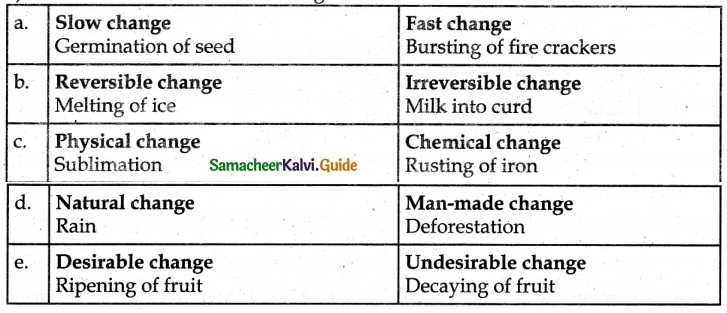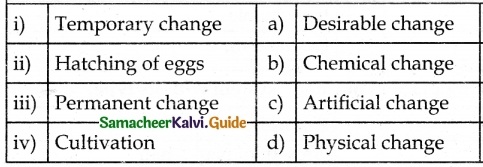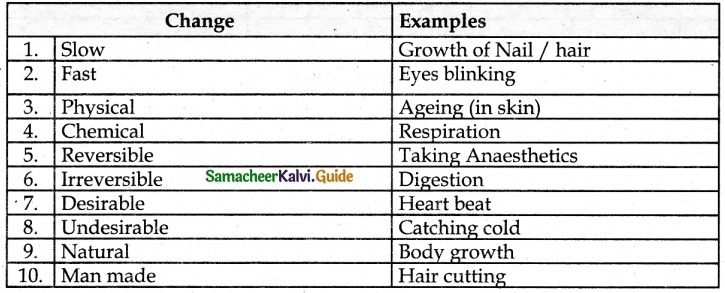Students can download 6th Science Term 2 Chapter 3 Changes Around Us Questions and Answers, Notes, Samacheer Kalvi 6th Science Guide Pdf helps you to revise the complete Tamilnadu State Board New Syllabus, helps students complete homework assignments and to score high marks in board exams.
Tamilnadu Samacheer Kalvi 6th Science Solutions Term 2 Chapter 3 Changes Around Us
Samacheer Kalvi 6th Science Changes Around Us Text Book Back Questions and Answers
I. Choose the Correct Answer
Question 1.
When ice melts to form water, change occurs in its
(a) position
(b) colour
(c) state
(d) composition
Answer:
(c) State
Question 2.
Drying of wet clothes in air is an example of
(a) Chemical change
(b) Undesirable change
(c) irreversible change
(d) physical change
Answer:
(d) Physical change
![]()
Question 3.
Drying of wet clothes in air Is an example of
(a) Chemical change
(b) Undesirable change
(c) irreversible change
(d) physical change
Answer:
(d) physical change
Question 4.
Out of the following an example of a desirable change ¡s
(a) rusting
(b) change of seasons
(c) earthquake
(d) flooding
Answer:
(b) change of seasons
Question 5.
Air pollution leading to Acid rain is a
(a) reversible change
(b) fast change
(c) natural change
(d) human made change
Answer:
(d) human made change
II. Fill in the blanks
- Magnet attracts iron needle. This is ……… change, (a reversible / an irreversible)
- Boiling of egg results in ………… change, (a reversible / an irreversible)
- Changes that are harmful to us are ………… (desirable / undesirable)
- Plants convert Carbon-di-oxide and water into starch. This is an example of ………. change, (natural / human made)
- Bursting of fire crackers is a ……….. change whereas germination of seeds is a ………. change, (slow / fast)
Answer:
- a reversible
- an irreversible
- undesirable
- Natural
- fast; slow
![]()
III. True or False. If False, give the correct statement
- Growing of teeth in an infant is slow change.
- Burning of match stick is a reversible change.
- Change of New moon to Full moon is human made.
- Digestion of food is a physical change.
- In a solution of salt in water, water is the solute.
Answer:
- True
- False – It is an irreversible change
- False – It is a Natural change
- False – It is a Chemical change
- False – Water is the solvent
IV. Analogy
Question 1.
Curdling of milk : irreversible change ::
Formation of clouds : ……….. change
Answer:
reversible
Question 2.
Photosynthesis : ……….. change ::
burning of coal : Human – made change
Answer:
Natural
Question 3.
Dissolving of glucose: reversible change ::
Digestion of food : ………… change
Answer:
Irreversible
![]()
Question 4.
Cooking of food : desirable change ::
decaying of food : ………… change
Answer: undesirable
Question 5.
Burning of matchstick: ………… change ::
Rotation of the Earth : Slow change
Answer:
Fast
V. Circle the odd one out. Give reason for your choice
Question 1.
Growth of a child, Blinking of eye, Rusting, Germination of a seed.
Answer:
Blinking of eye (a fast change)
Question 2.
Glowing of a bulb, lighting of a Candle, breaking of a coffee mug, curdling of milk.
Answer:
Curdling of milk (a chemical change)
Question 3.
Rotting of an egg, condensation of water vapour, trimming of hair, Ripening of fruit.
Answer:
Trimming of hair (Man-made change)
Question 4.
Inflating a balloon, popping a balloon, fading of wall paint, burning of kerosene
Answer:
Burning of Kerosene (Chemical change)
![]()
VI. Give a very short answer
Question 1.
What kind of change is associated with the decaying of plants?
Answer:
Decaying of plants is associated with slow change and chemical change.
Question 2.
You are given some candle wax. Can you make a candle doll from it? What kind of change is this?
Answer:
Yes, I can make a doll from the candle. The kind of change is a physical change.
Question 3.
Define a slow change.
Answer:
Changes which take place over a long period of time (hours/days/months/years) are known as slow changes.
Question 4.
What happens when cane sugar is strongly heated? Mention any two changes in it.
Answer:
When Cane sugar is strongly heated, it will initially melt and after that start to decompose. It will turn brown and then black and give off fumes.
The changes involved are:
- Physical change
- irreversible change
Question 5.
What is the solution?
Answer:
When a solute is dissolved in a solvent, it forms a solution.
Solute + solvent → solution.
VII. Give a short answer
Question 1.
What happens when the paper is burnt? Explain.
Answer:
When the paper is burnt, oxygen from the air combines with carbon in the paper turning into carbon dioxide and water vapor which float away, leaving solid ash. The action of burning paper can’t be reversed. So, it is an irreversible change. Also, it is a Chemical change and a Fast change.
Question 2.
Can deforestation be considered a desirable change? Explain.
Answer:
- Deforestation cannot be considered a desirable change.
- Because it is harmful to our environment and not desired by us are known as Undesirable changes.
Question 3.
What type of changes is associated with the germination of a seed? Explain.
Answer:
- Germination of seed is a slow change.
- Changes which take place over a long period of time (days) are known as Slow changes.
![]()
VIII. Answer in detail
Question 1.
Give one example in each case that happens around you.
(a) Slow and fast change
(b) Reversible and irreversible change
(c) Physical and chemical change
(d) Natural and man-made change
(e) Desirable and undesirable change
Answer:

IX. Questions Based on Higher Order Thinking Skills (HOTS)
Question 1.
When a candle is lit the following changes are observed.
Answer:
- Wax melts.
- Candle keeps burning.
- The size of the candle decreases.
- The molten wax solidifies
Question 2.
Which of the changes can be reversed? Justify your answer.
Answer:
When the candle is burning, the heat of the flame melts the solid wax to liquid wax. This signifies reversible (or) Physical changes. Also, as the wax melts, the size of candle decreases. If then molten wax solidifies and takes a different shape.
Samacheer Kalvi 6th Science Changes Around Us Additional Important Questions and Answers
I. Choose the appropriate answer
Question 1.
Water changes into ice on cooling are called as
(a) Melting
(b) Vaporisation
(c) Condensation
(d) Freezing
Answer:
(d) freezing
Question 2.
_______ is the process in which something becomes different from what it was earlier.
(a) Classification
(b) Composition
(c) Position
(d) Change
Answer:
(d) Change
![]()
Question 3.
Evaporation of water from lakes and river
(a) Slow change
(b) Fast change
(c) Natural change
(d) Both (a) and (b)
Answer:
(d) Both (a) and (b)
Question 4.
_______ change is a temporary change
(a) Physical
(b) Chemical
(c) Undesirable
(d) slow
Answer:
(a) Physical
Question 5.
The blackening of the Silver anklet is a (an)
(a) Irreversible change
(b) Temporary change
(c) Short term change
(d) Periodical change
Answer:
(a) Irreversible change
II. Fill in the blanks
- A change in which a new substance is formed is called ………….
- Formation of coal is a …………
- An example of natural as well as an undesirable change is ………..
- ……… is the Universal Solvent.
- Eco-friendly changes are ………
Answer:
- Chemical Change
- Slow Change
- Earthquake
- Water
- Desirable changes
III. Match the following

Answer
i. – d
ii. – a
iii. – b
iv. – c
IV. Analogy
Question 1.
Rusting of Iron : undesirable change : : Dead plants turn into manure : …………..
Answer:
Desirable change
Question 2.
Touch me not plant: ………… : : digestion of food : Irreversible change
Answer:
Reversible change
![]()
Question 3.
Change of seasons : slow change : : Breaking of glass : …………..
Answer:
fast change
Question 4.
Earth quake : undesirable change : : Heartbeat: ………….
Answer:
desirable change
Question 5.
Silver articles turning black : ………… : : Boiling of H2O : physical change
Answer:
Chemical change
V. Very short answer
Question 1.
What is the change?
Answer:
Change is the observable difference between the initial state and the final state of any substance.
Question 2.
What is a reversible change?
Answer:
Changes which can be reversed (to get back to the original state) are known as reversible changes.
Question 3.
What is melting? Give example.
Answer:
The conversion of a solid into a liquid by heating is called melting. Ex.: Ice into water.
Question 4.
Water is the universal solvent. Why?
Answer:
Water is known as the universal solvent. It dissolves a wide range of substances.
![]()
VI. Long answer
Question 1.
Distinguish between the physical and chemical changes.
Answer:

Question 2.
Tabulate some changes taking place in our body system with its type.
Answer:
